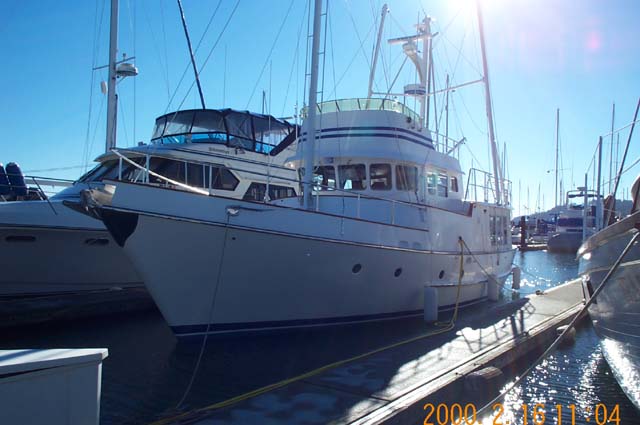
Visual Sea: History & Specifications

Visual Sea (February 2000, Anacortes, Washington)
One problem: my wife didn't want to live on a sailboat! She enjoyed day sailing, but the sailboats we had seen were too small and living life heeled over 30 degrees just wasn't going to cut it for her. I discovered Nordhavns in the early 1990s and came back to explore them, and after visiting Pacific Asian Enterprises (aka Lamest Yacht Sales, aka the Nordhavn people) in Dana Point California in February of 1998, I ordered our Nordhavn 46 trawler in April of 1998. It was to be hull #64. These boats have been made since the late 1980s and have more blue water circumnavigations than any other power boat made.
These boats are called trawlers because they are slow, i.e., they go less than 10 mph! However, their full displacement hulls allow them to get actual miles per gallon instead of gallons per mile, and they can actually go anywhere in the world as a result. Performance specifics are below.
Here is the final interior layout of our particular Nordhavn, N4664:
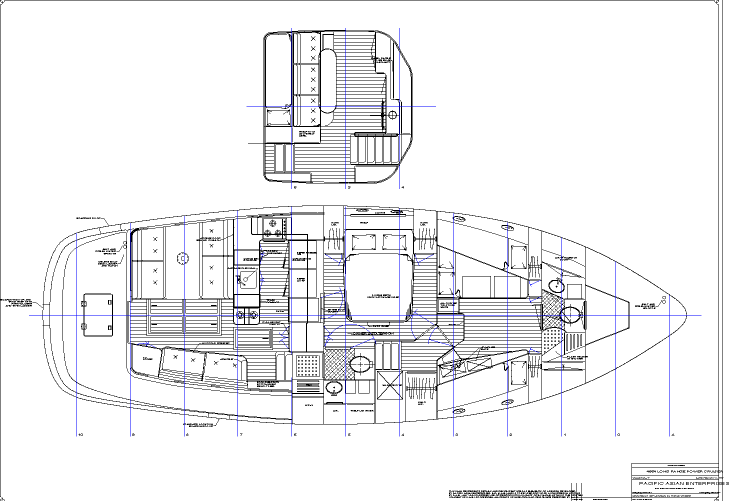
Specifications and Technical Details
Dimensions:
|
Length overall: |
45' 9.25" + swimdeck |
|
Length, waterline: |
38' 4.0" |
|
Beam, maximum: |
15' 5.0" |
|
Beam, waterline: |
13' 8.5" |
|
Draft: |
5' 0.0" |
|
Height: |
37' 2" from waterline to top of foremast |
|
Displacement: |
48,320 pounds; approximately 60,000 pounds loaded |
|
Fuel Capacity: |
1,300 US Gallons |
|
Water Capacity: |
300 US Gallons |
|
Primary Power: |
Lugger L-6414D 6 cylinder inline 4 stroke diesel (L668D) |
|
Power: |
143 HP @ 2500 RPM |
|
Displacement: |
414 cu. in. (6.78 L) |
|
Bore/Stroke: |
4.19 in x 5.0 in |
|
Compression Ratio: |
16.8:1 |
|
Aspiration: |
Natural |
|
Backup Power: |
27 HP Yanmar diesel engine |
|
|
Ketch sailing arrangement |
|
Generator: |
8 kW Northern Lights diesel generator |
Fuel Consumption:
| Engine Speed | Fuel Consumption | Specific Consumption | Available Power |
|
|
|
|
|
|
|
|
|
|
|
|
|
|
|
|
|
|
|
|
|
|
|
|
|
|
|
|
Speed / Range:
| Speed (knots) | S/L | HP | Gal/Hr | Hours | Range (NM) |
|
|
|
|
|
|
|
|
|
|
|
|
|
|
|
|
|
|
|
|
|
|
|
|
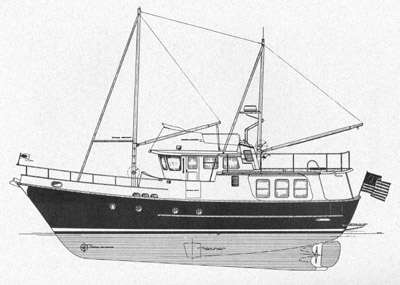
Hull Construction:
Hand laid GRP single series of laminates with transverse and longitudinal stringers. Hull fitted with heavy full-length fiberglass and stainless steel rub strake.
Deck Construction:
Hand laid GRP with a vertical end grain balsa core in all horizontal surfaces and "divincel" foam core in all vertical surfaces. Standard boat to have diamond pattern non skid on deck surfaces.
Propulsion:
A single Lugger 143 HP diesel with fresh water keel cooling and commercial type stainless steel dry exhaust system. Hydraulic transmission with a 3 to 1 reduction gear propeller shaft is 21/4" stainless steel and a four bladed bronze propeller is standard. Dual lever Morse controls for transmission and throttle are provided at both stations. Deluxe engine panel with complete instrumentation and alarms for low oil pressure and high water temperature. Two 12 volt engine room blowers are standard: one that always operates, as well as an extra high capacity blower.
Auxiliary propulsion:
An auxiliary propulsion engine, a 27 HP Yanmar diesel, drives a Martec folding sailboat propeller. The auxiliary engine will push the vessel at approx. 5 knots and provide 50 amps of 12 volt battery charging capability. Location is in the machinery space under main salon.
Bow Thruster:
A 10 inch 24 VDC Trac dual prop American Bow Thruster provides ease of docking. Two jog lever style thruster control stations are provided, as well as a separate set of two 8D 12V batteries to supply the 400 A of current required to use the thruster. These batteries have their own 12V battery charger.
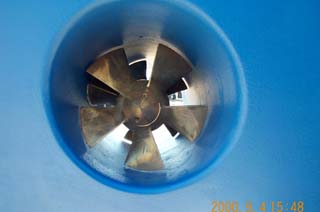
Generator:
An 8 KW Northern Lights generator is provided. Standard electrical system has provision for ship's AC. Service with appropriate switches, meters and breakers.
Fuel system:
Total capacity 1,300 gallons. Two fiberglass fuel tanks with external sight gauges. Large inspection plates and internal baffles. Fuel lines to be fuel certified reinforced rubber and "airquip" type fittings to absorb engine vibration. Two large Racor fuel filter/water separators deliver clean fuel to the engines.
Steering system:
Hydraulic steering system is standard. An emergency tiller is provided and stowed in the lazarette.
Bilge pumps:
One regular electric bilge pump with auto and manual switches along with a single hand operated Edson diaphragm pump are standard. In addition there is a second high capactiy automatic electric bilge pump in case of emergencies. Electric pumps are wired into red warning lights at the helm station warning of bilge pump operation.
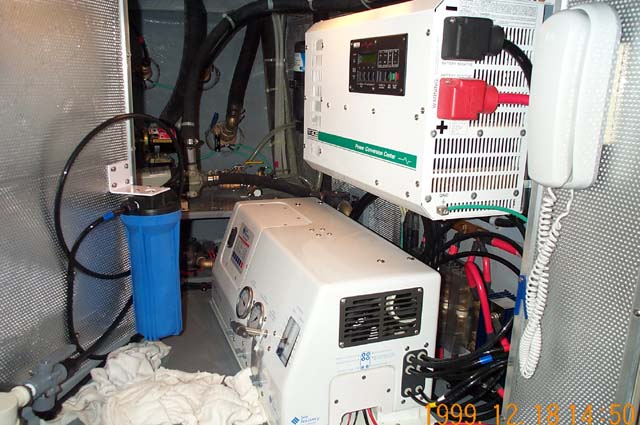
Fresh water system:
300 gallons in five stainless steel tanks with selection manifold located in galley. Par pressure pump with seaward 11 gallon dual source water heater. Manual foot pump located in galley. Shower sump pumps in both owner and guest heads, as are flash water heaters for both showers. One 170 gallon per day 12V watermaker provides unlimited fresh water.
Electrical:
Two 120 amp and three 200 amp 12 volt batteries are standard with one dedicated to engine starting. A 130 Amp engine alternator charges batteries underway and an 150 A inverter/charger handles them at dockside or when running the generator. A separate 40 Amp battery charger keeps the generator, main, and wing engine starting batteries topped off when dockside. The engine starting battery is isolated from the house batteries by a diode system which allows charging by one source. Ample AC outlets are provided throughout the boat including the cockpit and engine room. Plenty of 12V DC lights are positioned throughout. A halogen lamp illuminates the foredeck while a pair of spreader lights light the upper aft deck. Red theater lighting illuminates the interior of the boat at night, especially the stairs. Reading lights are available in the pilothouse, the salon, and over all berths.
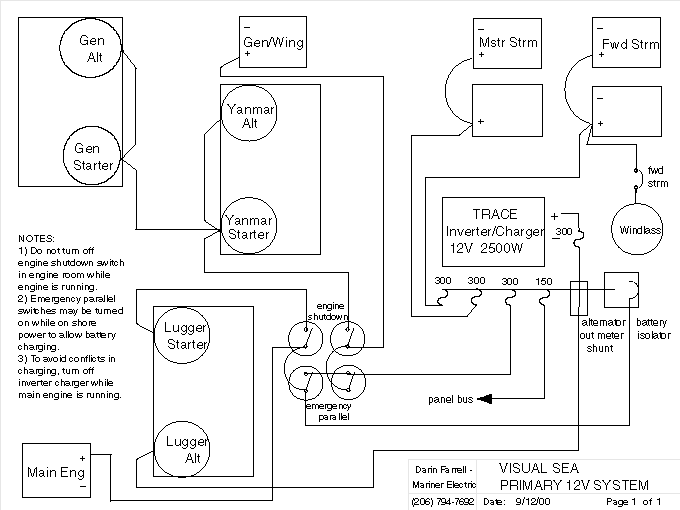
Electronics:
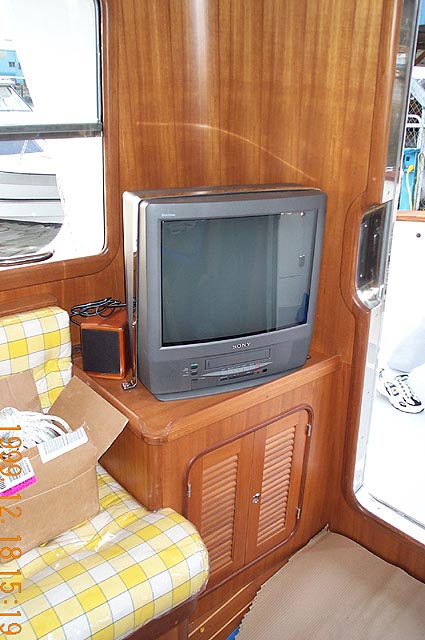
Interior:
General exterior:
All exterior hardware are high grade, electropolished stainless steel. All opening ports are of stainless steel. All window frames are fabricated of stainless steel.
Back to Dan's home page.
Created: 29 Mar 1998 Modified: 5 Mar 2001